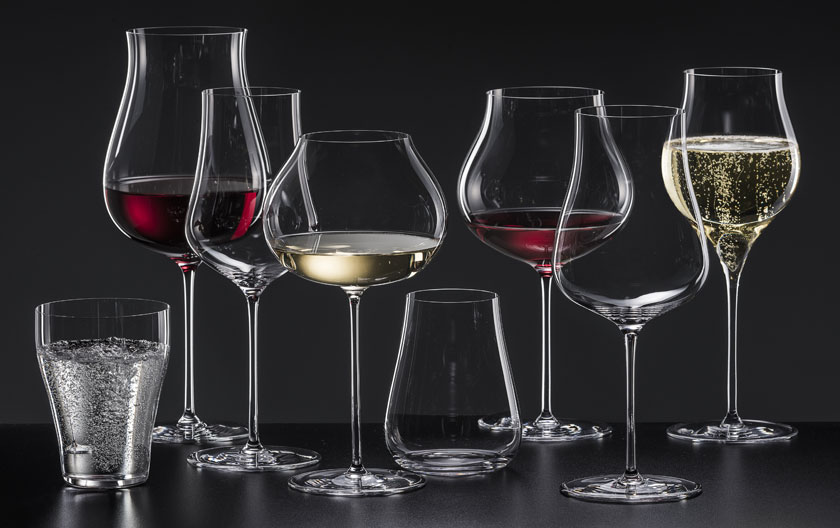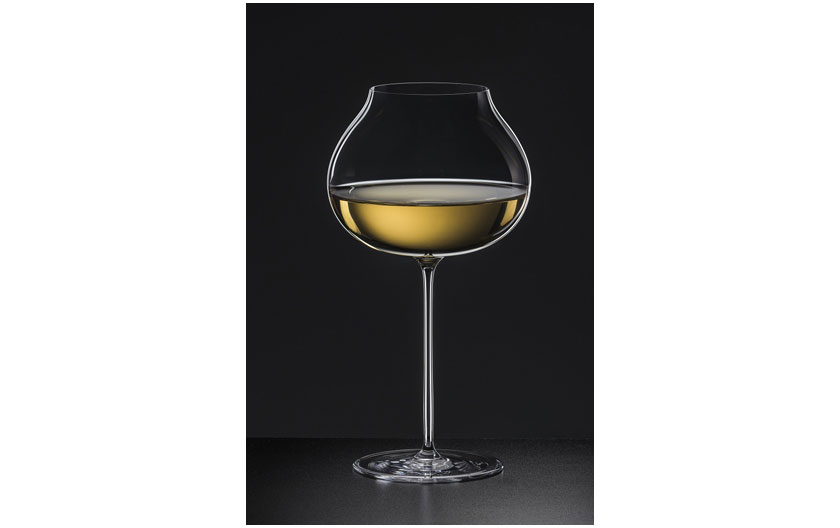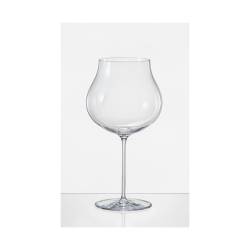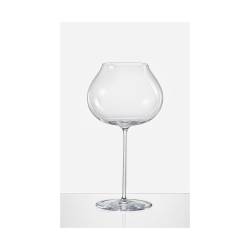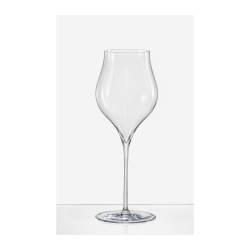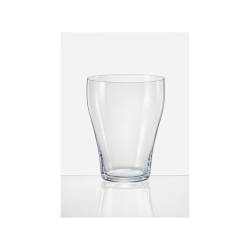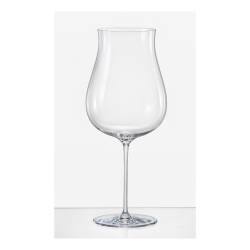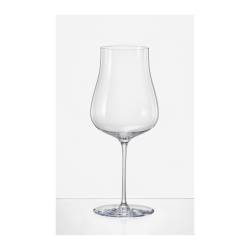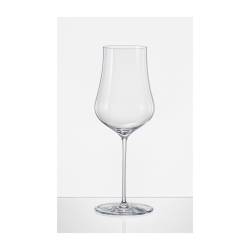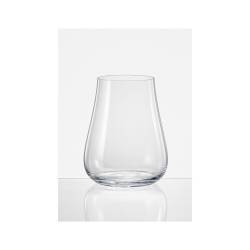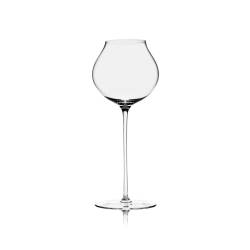THE LINE OF GLASSES THAT DISRUPTS THE WAY WINE IS SERVED
What is Rona's Umana line?
More importantly, why did RG think it was necessary to offer it to its customers?
The first question deserves a detailed explanation, which will consequently help answer the second one as well.
WHAT ARE THE KEY FEATURES?
The making of the glass with a new technology, a machine that perfectly reproduces the qualities of blown glasses while being mechanical.
Ultra thin, extra light, bright and transparent, shiny, dishwasher safe, with a super-stretched stem.
Rona Glassworks has been ahead of itstime continuously without ever ceasing to look at its traditional side, that department of the company where glasses are still mouth-blown. Rona has as many as 300 people to make these goblets. Unfortunately, however, artisans capable of producing glasses in such a refined but also complex way are fewer and fewer, so the company has once again looked to the future, investing heavily in a new technology. It is a method of making to create blown goblets but ... by machine .
IT'S NOT FANTASY, IT'S REALITY, THANKS TO RONA
Very recently, the company introduced the claim '2serve '(to serve) in its logo, and this is emblematic of how much more and more it puts itself at the service of its customers, thoroughly understanding their needs.
What need are we talking about in this case? That of continuing to guarantee a product of the highest level but at a price cut in half compared to traditional blown glasses .
In fact, if you happened to hold in your hand a mouth-blown and a machine-blown glass from Rona's Umana line, you certainly would not be able to grasp the differences.
NOT JUST GLASS, EMOTION
RONA: A BIT OF HISTORY
Rona is a glass industry with more than 1,000 employees in the heart of the European Union, in the Slovak Republic.
Its history dates back to 1892, when it was founded by the Schreiber family, one of Europe's leading glass manufacturers, in a region where glassmaking traditionally arose and flourished as early as the Bronze Age.
From the earliest days, Rona has always used state-of-the-art technology and has been a leader in glass production.
In 1893 Rona was the first glassworks to launch glass production using the pressed technique.
In 1896 it introduced sophisticated pantograph decoration technology.
In 1956 Rona was the first factory in the world to implement and perfect the production of handmade stemware through the stretched stem process imitated today by all well-known handmade stemware manufacturers.
Finally, in 2001 Rona also introduced, as the first glass factory in the world, blow-blow technology in the commercial production of expanded stemware. This technology gives Rona the expertise to elevate the production of professional foodservice crystal to a new level.
To date, Rona produces more than 70 million ISO 9002-certified high-quality crystalware items.
HUMAN LINE: FROM MAURIZIO FILIPPI'S HAND TO REALITY
For the first time in history, a line of glasses designed by those who use these tools and from whom they demand maximum results in their use.
Maurizio Filippi, Best Sommelier AIS of Italy 2016, rests in the contours of the soft, 'human' lines, all his experience as a taster and restaurateur, without neglecting the business considerations of those who choose the glasses.
Only six wine glasses and 2 water glasses to gather the needs that all professionals and wines produced in the world may require.
This is the first time the company has collaborated with an outside consultant, but it seems that the result was really excellent.
THE DRAFT STEMMING FROM THE WOMB IDEA THOUGHT UP BY MAURIZIO FILIPPI
'I tried to translate into a series of 'drafts' of glasses what my experience told me was missing and I did it with a pencil on a paper, I didn't draw a line of glasses, but I translated my experience! This is me and my name is Maurizio Filippi, a 55-year-old man who still believes in fairy tales'
It is from this romantic premise that Umana was born, a line whose sinuous shapes are inspired by the source from which all things in the world are born: the womb.
A LINE OF STEMWARE DEDICATED TO THOSE WHO KNOW HOW TO APPRECIATE IT
There are two foundations from which the thought leading to the realization of this project stems.
The first stems from the bitter consideration that for too long glasses have become - and consequently considered - furnishing accessories. They have lost the true meaning for which they were designed. But just as the customers in front of us have changed in their perception of the tasting experience, so too has wine gained weight, structure, and quite different characteristics in recent decades, especially due to the incredible climate changes.
That is why it is necessary for the very shape of glasses to make the best expression of the qualities of wines that can be so appreciated even by superficial and distracted tasters.
Indeed, there will always be a desire to adapt wine production, and thus that of glasses, to the tastes of the hand genre and thus the market.
The second premise is a consequence of the first. The distraction of those who should experience the moment of the table and thus the wine thwart the qualities related to temperatures and aromas so sought after by those who made it.
A TOOL FOR WINE BEFORE IT IS FOR THE TABLE
Very few people are able, even in an optimal condition, to listen to their senses, breathe in the plate and the glass, close their eyes and let an imagination led by scents and colors live.
Hence the search for forms capable of satisfying the needs of the most meticulous sommelier and enthusiast in the service of all types of wines (and water), but reduced to such a number as to allow perfect management in both purchasing and storage and replenishment needs. Forms capable of addressing the highest levels of catering and tasting, but also those venues where through an even smaller number of types, want to ensure elegance and effectiveness in service.
THE HANDMADE BY MACHINE PROJECT
Traits inspired by the female womb that collects the meaning of life, as we said.
Indeed, let us remember that the real result of tasting is to get to perceive the intent of the one who produced that wine.
Two distinct glasses of water take shape, therefore, oriented toward the best expressiveness of the two major categories of the same, namely, natural or still and sparkling, either from natural effervescence or added carbon dioxide.
One mother shape for a goblet was created to suit every need, and from this, goblets of different shapes and sizes were devised, simply trying to shape the different sensations that the world's various types of wines offer us.
MACHINE-BLOWN GLASS THAT EXCITES BY ITS HUMANITY
The shape of this line is not only meant to reproduce the human profile, but aims at that sinuosity that wants to force the wine to breathe, even to the most distracted or focused elsewhere. The swirl of aromas that can develop from a wine served at the right temperature 'in the lap' of the goblet has a circular, spherical movement, aided by the softness of the spaces.
The slightly flared profile, inviting toward the outflow of aromas, 'forces' in the moment of drinking to breathe in those scents from the goblet, perfectly smooth in its inner part, invites out and allows to complete the perfect perception of the wine.
THE HUMAN LINE IN THE WORLD
The project was officially launched at NRA Chicago 2019 internationally and then at Host 2019 for Europe.
RG did not miss the opportunity to introduce the line in full, seizing its potential.
Assortment in glassware has always been our strength, which is why we saw the Umana line as the glass of the future, the one that will enable an ever-widening panorama of restaurateurs and enthusiasts to enjoy excellent products at extremely competitive prices.

